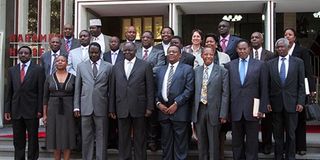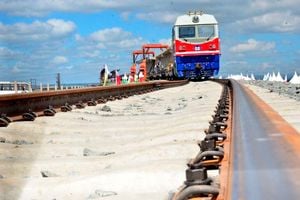Correcting Constitutional mistakes of Naivasha

President Kibaki (right) and Prime minister Raila Odinga, with some members of the Committee of Experts on constitution review outside Harambee House on Tuesday. Photo/ FREDRICK ONYANGO
What you need to know:
For the first time in the history of the architecture of constitutions in the world, a Senate was designated as a ‘lower house’.
This had never happened anywhere else in the world. Even during the Roman Empire, the Senate was designed as the ultimate stamp of the people’s authority.
The CoE had drafted a seamless legislative system where Bills and oversight reports would originate from the National Assembly and proceed to the Senate for approval, amendment or rejection.
Do I support constitutional amendments? Yes, I do. First, the 2010 Constitution was not singularly a document by the Committee of Experts (CoE). The constitutional review process was a bus full of passengers, conductors and touts — all of whom had vested interests. The document which was singularly the product of CoE was ‘The Harmonized Draft’ that captured the spirit of the Bomas Draft, the Kilifi Draft, and the Wako Draft.
CHAOTIC CHANGES
The Harmonised Draft was required, by law, to be submitted to the Parliamentary Committee on the Review of the Constitution sitting in Naivasha. At Naivasha, this committee made ad hoc, chaotic changes that altered key aspects of the design of the document. A few examples will suffice:
One, it is at Naivasha that, for the first time in the history of this country, the idea of a pure presidential system of government was born. It was never in our Independence Constitution, the Post-Independence amended Constitution, the Bomas draft, the Kilifi draft or the Wako draft. The Harmonised Draft created a hybrid system of government with powers cascading from an elected presidency to a Prime Minister elected by Parliament and two Deputy Prime Ministers also elected by Parliament.
Two, Naivasha also threw out the proposal that Cabinet Ministers be drawn from both parliament and professionals. This model was recommended to enable the president to tap expertise across the board as well as to accommodate political interests. But importantly the Cabinet would be answerable both to the president and parliament. This is a cardinal requirement in the delicate system of checks and balances.
PUBLIC POLICIES
Three, Naivasha also threw out the Office of Leader of the Official Opposition. This is the ultimate symbol of checks and balances in governance. A person and a party that has the support of over five million voters cannot be overlooked just because it lost the election.
Such a party must be given the honour of oversight in governance and the right to constitute an alternative government. The leader of such a party would be in parliament to lead his troops. In the wake of the ‘handshake’, the importance of this office is clear to all.
Four, Naivasha in its wisdom also overrode the proposal that a presidential candidate could simultaneously contest a National Assembly or a Senatorial seat.
Again, these provisions were purposive. The idea was to create harmony in governance by ensuring that party leaders sit in parliament to formulate and guide coherent responses to public policies and legislation. We now have an awkward situation where opposition leaders consult with their MPs in hotels.
CONFRONTATION
Five, the greatest tragedy from Naivasha was the mutilation of the Senate. For the first time in the history of the architecture of constitutions in the world, a Senate was designated as a ‘lower house’. This had never happened anywhere else in the world. Even during the Roman Empire, the Senate was designed as the ultimate stamp of the people’s authority. The CoE had drafted a seamless legislative system where Bills and oversight reports would originate from the National Assembly and proceed to the Senate for approval, amendment or rejection. The Bills would then proceed to the presidency for assent. It was envisaged that the system would provide quality legislation and microscopic oversight. We tried to repair the damage done to the Senate by giving it some powers, particularly in relation to devolved governance. We also created mediation committees to avoid constant confrontation between the two houses. However, even this has not worked. These are some of the Naivasha outcomes which have come to haunt the nation. But there are other matters that have arisen which are unrelated to the Naivasha debacle.
JUDICIARY
The late British Prime Minister Harold Wilson once quipped: ‘A week in politics is a long time’. I say nine years and two elections in a country’s politics is a very long time. It is not humanly possible to anticipate every situation in constitution-making.
At CoE we, for instance, created a Judicial Service Commission with the majority being judicial officers. We did not foresee that they would use their majoritarian numbers to give themselves a dominance and a head-start in decision-making.
The recent recruitment of Court of Appeal judges from within the judiciary to the exclusion of the Bar and the academia was an eye-opener. Furthermore, the idea that judges can hear disciplinary cases against their colleagues or themselves has elicited grave misgivings. As such, it has become necessary to separate the JSC from the judiciary. Also, it is necessary to consider a situation where a governor is charged with a crime relating to his office. It may be necessary that he be suspended, in which case his deputy must assume full control of the office.
APPOINTMENTS
The powers of an acting governor have to be clearly defined.
The other identifiable gap is the lack of timelines upon the presidency. The presidency has been delaying in making many formal appointments.
This has affected the operations of some commissions, boards, and the JSC. At one time court orders had to be issued compelling the President to appoint judges. We had not anticipated such delays.
Statements have been made to the effect that the expansion of the executive is meant to benefit a few individuals. Such assertions are misleading. It is not possible to create an elective office then somehow give it to an individual. There has to be an electoral process, in fact, a General Election culminating in the direct election of the President and the election of the Prime Minister by parliament.
DEVOLUTION
The other misleading assertion is to the effect that the constitution should not be amended before its implementation is completed. Implementation had short term and long term phases. Certain laws, actions, and policies needed to be immediately undertaken to jump-start the enforcement of the constitution. These comprise, for example, the appointment of a new Chief Justice, the vetting of judges and the passage of devolution laws, etc. In the long term more than 600 pieces of legislation need to be either amended or repealed and re-enacted afresh.
Although the Building Bridges Initiative is welcome, there are valid concerns that it is not anchored in law. Constitutional amendments proposed by BBI, Punguza Mzigo, the Council of Governors, religious groups and all other stakeholders will have to be placed before Parliament whose duty it is to develop the way forward.
The author was the chairman of the Committee of Experts (CoE) that steered the 2010 constitution-making. This is an abridged version of submissions he has submitted to the National Assembly’s Committee on the Implementation of the Constitution.





